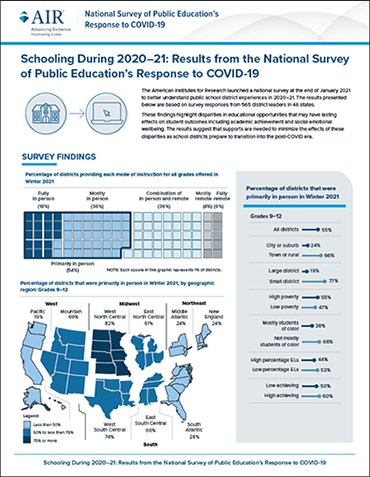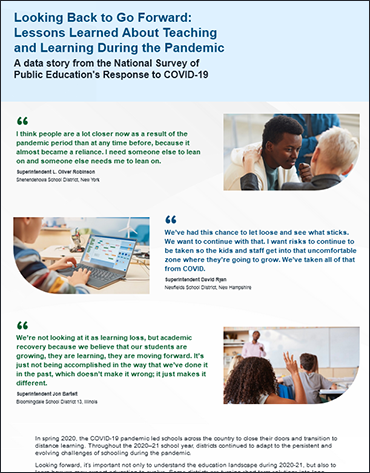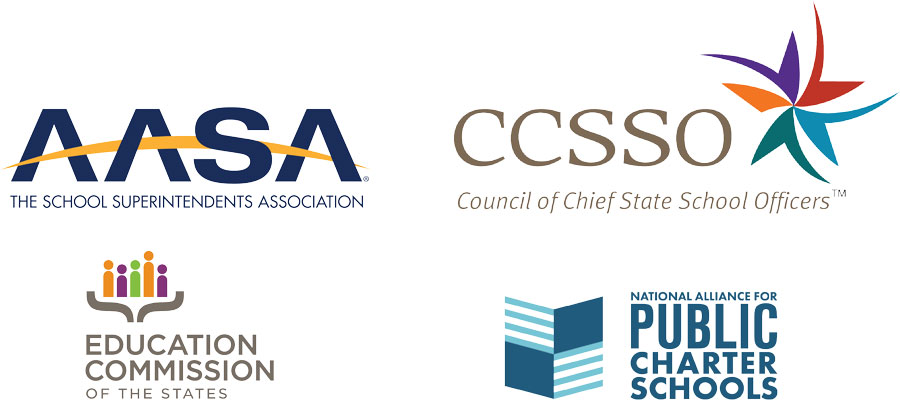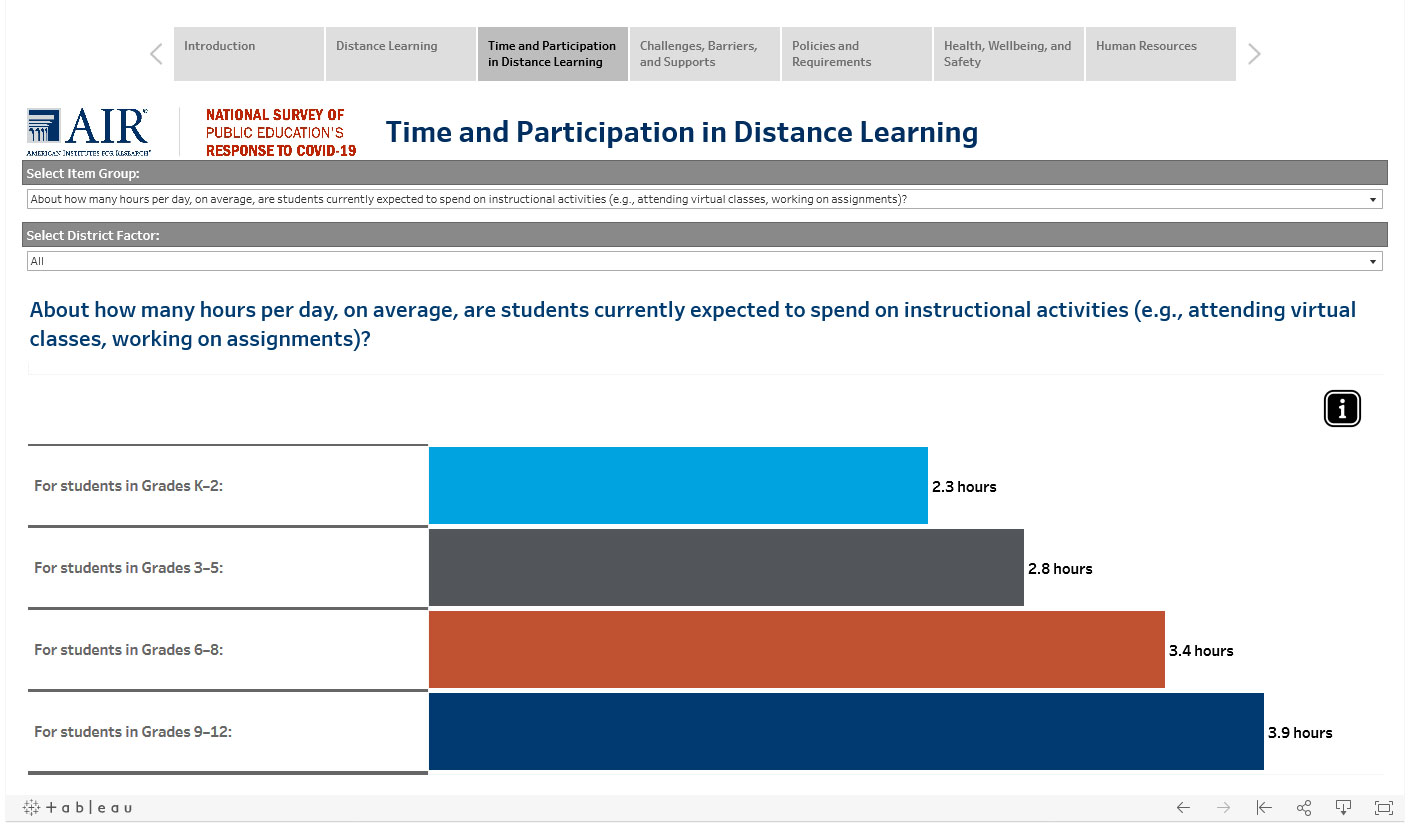National Survey of Public Education’s Response to COVID-19

Project Overview: Learning from the Pandemic
All of us—students, parents, educators, policymakers, and researchers—share an interest in learning from this event. To improve services to students and families as we move forward, we need information on what districts and charter management organizations are doing and plan to do to address COVID-19. Part of the AIR Equity Initiative, this project's main goals are to document this moment in education and to provide actionable information to educators, policymakers, and researchers to inform future education practices beyond the initial public health crisis.
The project was recognized in the inaugural 2022 Anthem Awards, which honor organizations and people who are doing work for social good across a variety of areas.
Project Timeline
- First Survey: In summer 2020, we asked school district and charter management organization leaders to respond to a nationally representative survey of school districts and charter management organizations—more than 2,500 in total—about the actions they have taken and the challenges they have encountered during the COVID-19-related school closures.
- Second Survey & Interviews: In spring 2021, the team administered a second survey to all school districts across the U.S. and conducted interviews with school district administrators on promising practices identified through survey responses.
Results At-a-Glance
Infographic
Schooling During 2020–21: Results from the National Survey of Public Education’s Response to COVID-19 (June 2021, PDF) highlights findings from the survey.

Data Story
Looking Back to Go Forward: Lessons Learned About Teaching and Learning During the Pandemic uses interactive graphics and videos to succinctly share the major findings and promising practices from across the entire project.

A 508 compliant version of the data story is also available.
Study Results
Quantitative Data: Use the Interactive Data Tool & Examine Research Briefs
Explore quantitative data findings, including an interactive data tool and in-depth research briefs.
Qualitative Data: Find Promising Practices
Explore qualitative data findings, including an interactive data matrix with promising practices by district demographics and district profiles of challenges and promising practices.
Communications
Podcast: Listen to our communications lead discuss crucial findings from the research briefs and how schools can take action to promote more equitable learning opportunities for all students.
Webinar: How COVID-19 Affected Education for Students with Disabilities and English Learners—The Latest Results from a National Survey (October 21, 2020) View the presentation slides (PDF).

Letters of Support
AASA, The School Superintendents Association (PDF)
Council of Chief State School Officers (PDF)
Education Commission of the States (PDF)
National Alliance for Public Charter Schools (PDF)
Quantitative Data: Use the Interactive Data Tool and Examine Research Briefs
Research Briefs (June/July 2021)
- Persistent Challenges and Promising Practices: District Leader Reflections on Schooling During COVID-19 (PDF)
- District Approaches to Instruction in 2020-2021: Differences in Instructional Modes and Instruction Time Across Contexts (PDF)
- Student Attendance and Enrollment Loss in 2020-2021 (PDF)
- District Concerns About Academic Learning During the COVID-19 Pandemic (PDF)
 Interactive Data Tool
Interactive Data Tool
This data exploration tool provides actionable data to educators, policymakers, and researchers to inform future education practices beyond the initial public health crisis. (The tool currently displays data for districts; data for charter management organizations will be part of a future update.)
Research Brief (April 2021)
Research Briefs (February 2021)
- Barriers and Supports: Teacher Familiarity with Digital Learning Tools (PDF)
- Social-Emotional Supports for Students During the COVID-19 Pandemic (PDF)
- Teacher Interactions with Students and Families During COVID-19 (PDF)
Research Briefs (October 2020)
- Spotlight on English Learners (PDF)
- Spotlight on Students with Disabilities (PDF)
- How District Approaches to Remote Instruction Differed Across Contexts (PDF)
Preliminary Results (July 2020)
- A quantitative brief, National Survey on Public Education’s Coronavirus Pandemic Response (PDF), which examined data on how schools reacted after the pandemic hit; and
- A snapshot, Voices of School District Leaders: National Survey of Public Education’s Response to COVID-19 (PDF), which includes school leader responses to questions about school innovation, promising practices, and challenges during the pandemic.
Technical Supplements
Qualitative Data: Find Promising Practices
Qualitative Briefs: District Profiles of Challenges and Promising Practices (November 2021)
In May and June 2021, AIR interviewed 20 district leaders about the challenges and promising practices they implemented to help address common, pandemic-related challenges during the 2020–21 school year. Six common themes emerged across interviews:
- Remote instruction policies and practices, such as which students would be allowed to learn remotely or how teachers would modify their roles.
- Supplemental learning supports, such as providing additional tutoring or asynchronous learning materials.
- Support for students with disabilities and English learners, such as virtual interventions or family supports.
- Personalized learning, such as individualized instruction, competency-based grading, and flipped classroom models.
- Social-emotional supports for families and students, such as community outreach, food delivery, and mental health supports.
- Social-emotional supports for staff, such as employee assistance funds and mental health supports.
